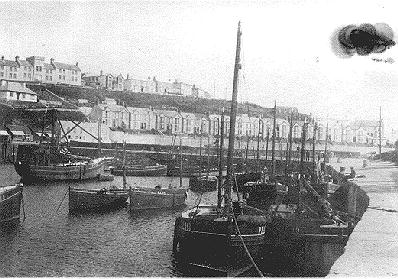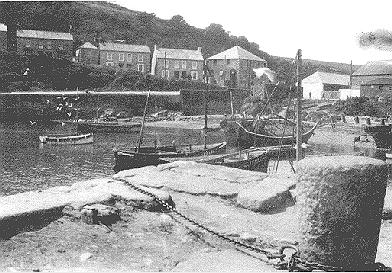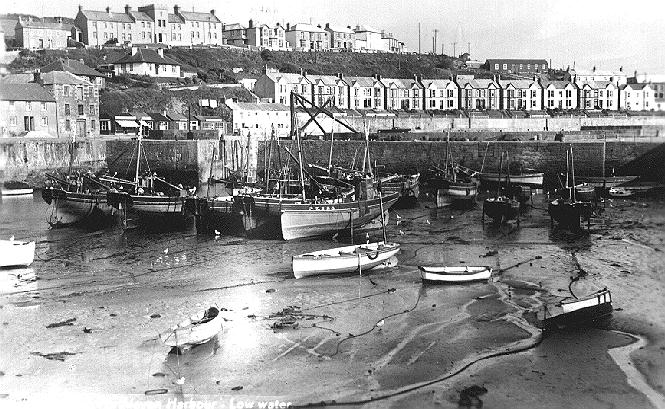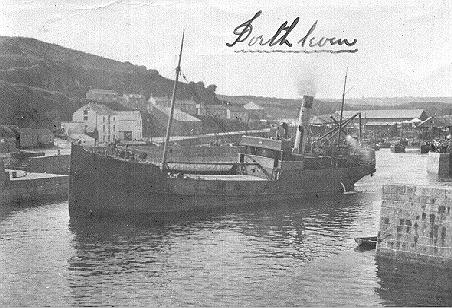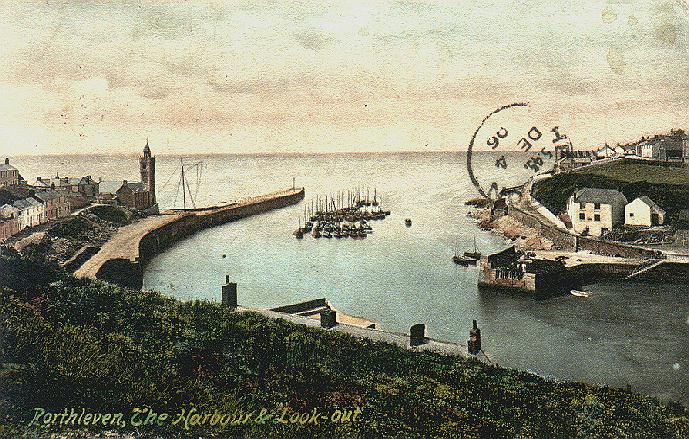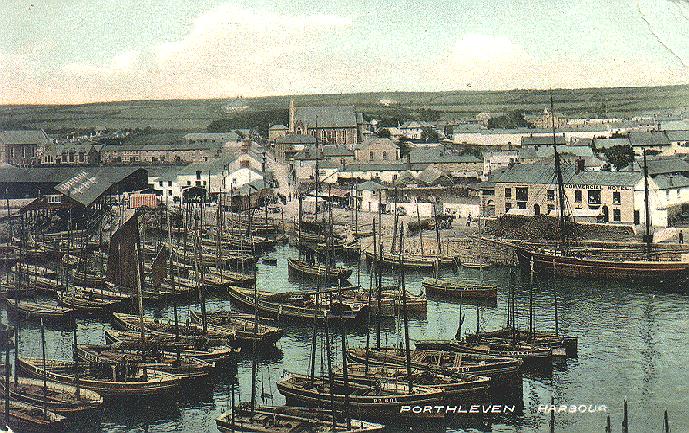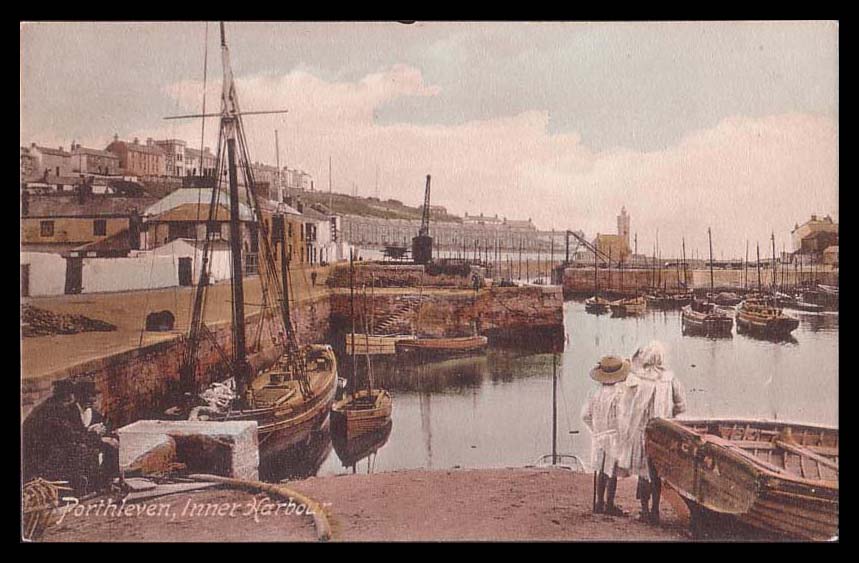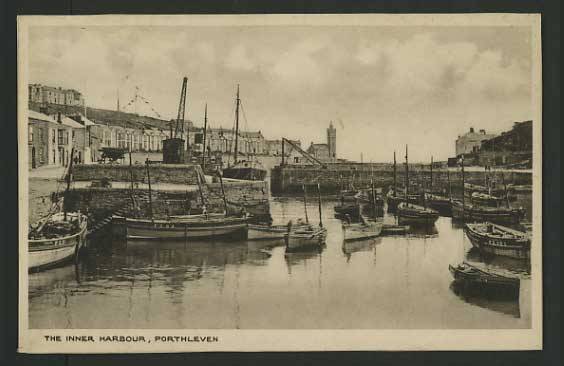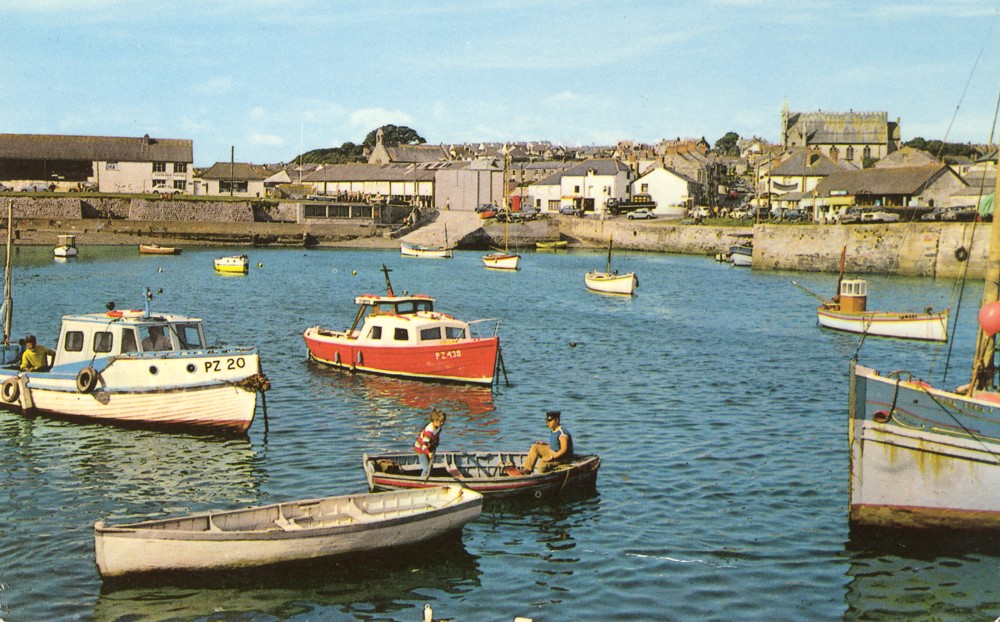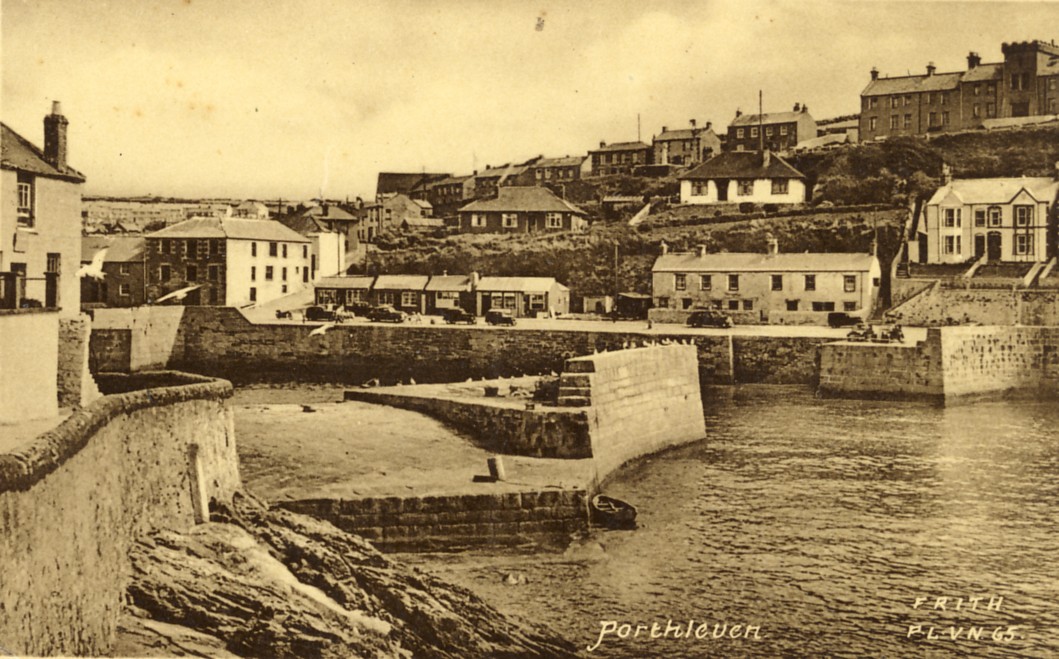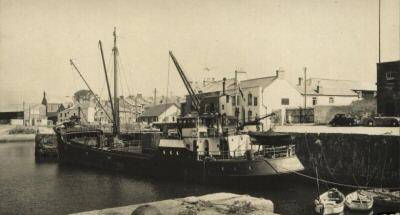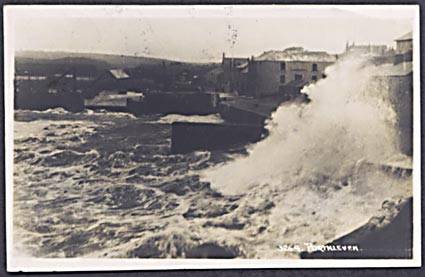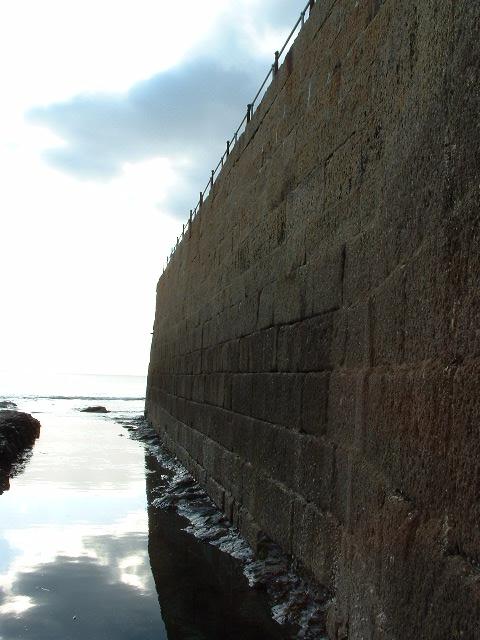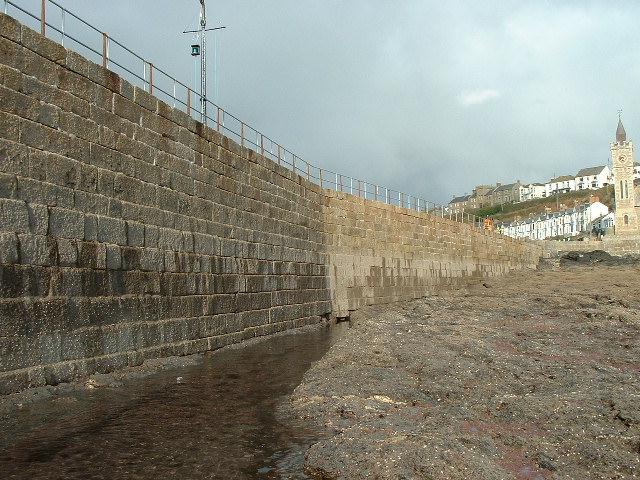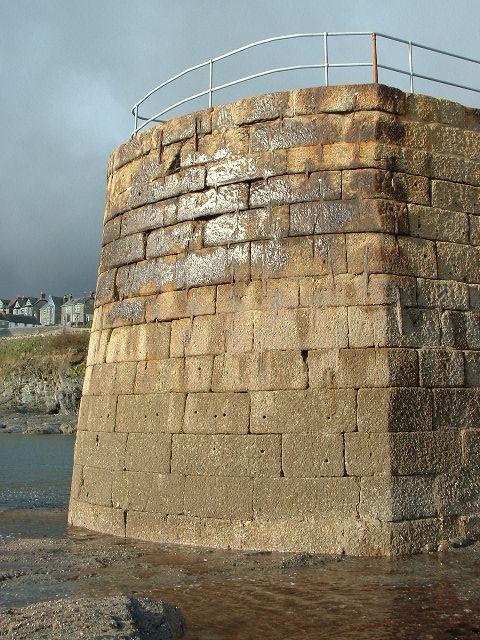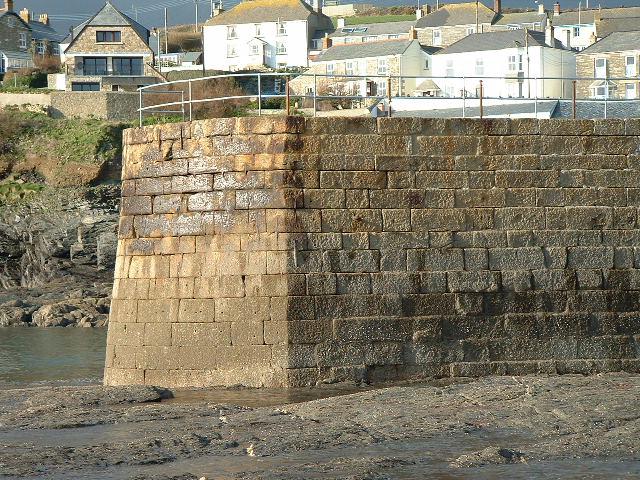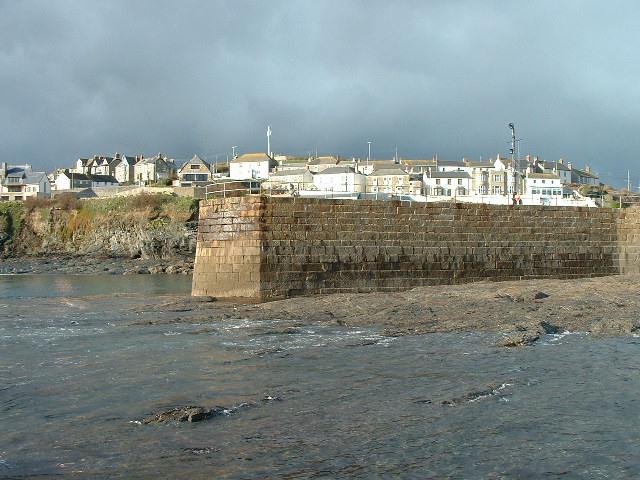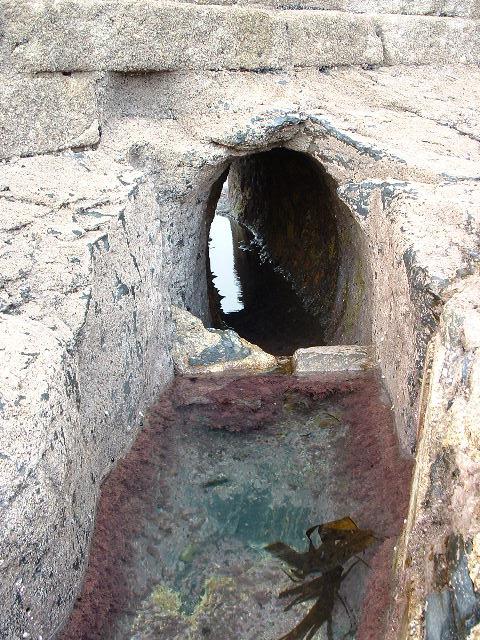Porthleven Harbour
By JAMES HOWARD HARRIS
Writing from Porthleven in 1885
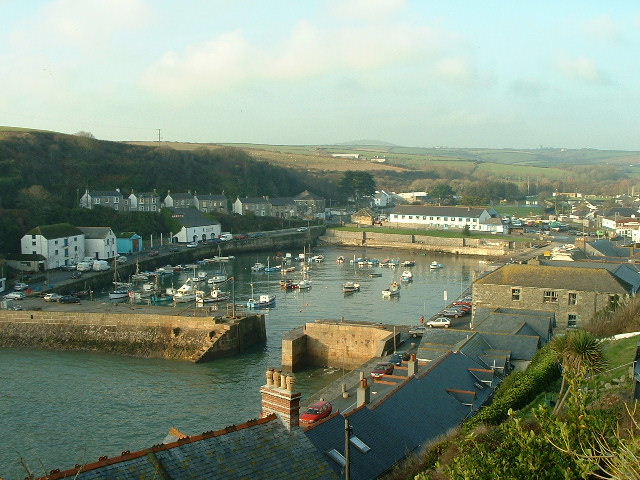
In the summer of 1810 a prospectus was printed by W. Penaluna, Helston, and also by a Fleet Street firm. It related to the ” Prince of Wales’ Harbour, to be constructed at Porthleven.” It stated : “The frequent occurrence of wrecks in the Mount’s Bay, and the distressing calamities thereby produced on lives and property, have been a matter of serious reflection with many persons for some time past. Within a very short space of time, not less than twelve vessels have been lost near, and within sight of, the inhabitants of Porthleven.” It proved, too, that surveys by competent engineers had been made of the cove, and it had been plainly demonstrated that a commodious, extensive, and safe harbour could be made. Such a haven would also prove a great boon to the fishermen; for it frequently happened on a change of wind, after the fish were caught, and before the carrying-boats could arrive from Mousehole and Newlyn – about eighteen miles westward – the nets were obliged to be taken up, and the fish abandoned, to save the boats. The latter, on such occasions, had to run to western ports, at a great risk, for want of a nearer shelter. Moreover, the proprietors of the fish secured were compelled to pay one-third of the catches as conveyance dues to the ports before mentioned – the only convenient curing places near. This would be saved by the construction of suitable curing-houses at Porthleven.
Speculators were invited to become shareholders, with a prospect of its proving a profitable undertaking. The harbour would be easy of access, and its situation in the midst of an important mining district would secure a trade in coals, timber, and the like. From the decomposition of the felspar in the Tregoning Hill granite good china clay could be obtained for export ; and besides, was there not a supply of the famous soap rock at hand – a mineral highly prized by the porcelain manufacturers? In cutting out the harbour basin there were great expectations of tin being found in the marshy bottom of the valley; so a smelting house could be constructed. As a fishing station, Porthleven would take its position – second to none in the country. A board of local gentlemen, among whom was John Rogers, Esq., the then Helston Mayor, and certain merchants of the same town, undertook the directorship until the Act of Incorporation was obtained.
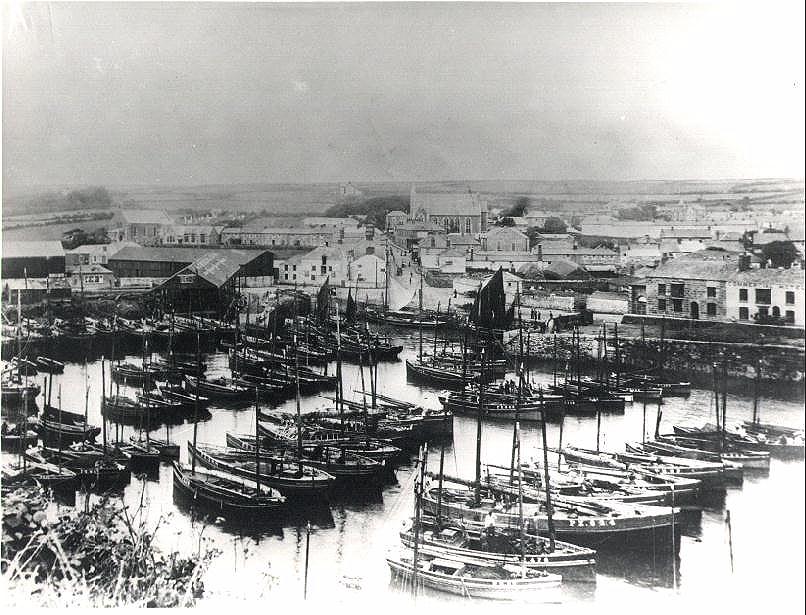
The sum of £30,000 was deemed sufficient for the formation of the harbour.
In 1811 an Act (51 Geo. III., c. 195) was passed for the construction of Porthleven Harbour.
By this Act fourteen directors were appointed, eleven of whom were to hold at least ten shares of £100 each. Among the original Directors mentioned in it were five M.P.’s and two clergymen; these, with the remaining directors and fifteen others, constituted the original Porthleven Harbour Company.
Their capital was to be £6o,ooo, in shares of £50 or £100 each; and, if necessary, they were empowered to issue 300 new shares of £100 each. When half the capital was collected they were to commence building the pier. If the harbour were not completed in five years from the passing of the Act the latter would cease to have effect. The company were also entitled to levy (1) tonnage duties for the use of the harbour; (2) Duties on all goods imported and exported; (3) Duties on profits of salvage; (4) Wharfage duties. They could also raise money by borrowing, and take lands for the purposes of the works.
Subsequent Acts were passed in 1813, 1816, 1821- 22, and 1869, whereby other powers were granted for the Regulation and Maintenance of Porthleven Harbour.
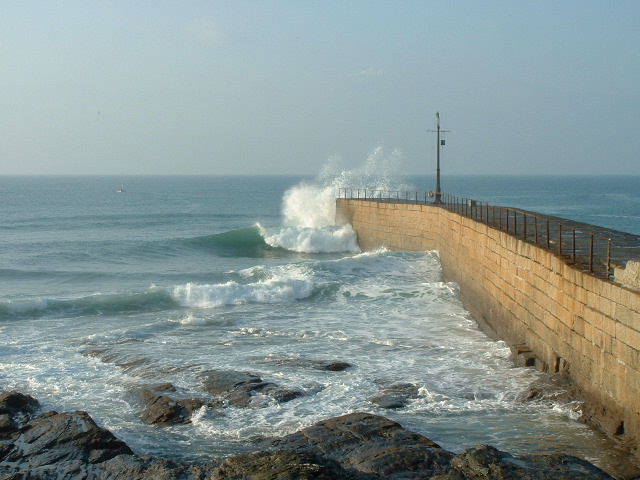
On the 18th October, 1825, the magistrates in quarter session assembled certified that Porthleven Harbour was completed to admit vessels of 200 tons, and in 1826 it was opened for traffic. The amount of capital and labour expended may be imagined when certain particulars are considered.
To remove the sandbar at the valley entrance was a considerable deed to accomplish. The construction of a strong granite pier, built on the rock, and extending into the sea, prevented the reaccumulation of the gravel. The shingle was wheeled in barrows by seventy workmen, and upset on the eastern side of the pier. The latter is 465 feet long, 26 feet high, and 21 feet wide, and is well able to withstand the force of the huge waves that the winter storms hurl against it. As first attempted, the pier was built from the shore outward; but the waves washed the masonry away. But under the direction of a Mr. Pearce, of Sheerness, the arrangement of the work was reversed, the building being commenced outside and then shoreward. The new plan proved successful.
At an expense of nearly £200,000 the harbour has been prepared for the reception of vessels of from 200 to 400 tons burden. There is a basin, within two solid granite jetties, with wharfage on each side for the landing of merchandise. The breadth of the harbour at the mouth of the basin, or narrowest part (between the jetties), is about 100 feet. The contents of the basin are:- Width at south end, next the jetties, about 230 feet; at, north end 360 feet length, north to south, 720 feet. Harbour and basin comprise about 28 statute acres. The sum of £8,ooo was paid by the company to purchase the land and old houses required in forming the roads, basin, etc.
It would be interesting to trace the varied changes in the history of Porthleven Harbour.
One company after another attempted to establish a trade, and to raise a revenue. Now we read of mortgage; afterwards of borrowed loans from the Exchequer Loan Commissioners. Twice it was advertised for sale, by public auction or by private treaty, but “nobody would have the harbour at any price.” The income derived from boats and vessels as Harbour Dues from 1816 to 1830 amounted to about £92 per annum. Debts were incurred by the Company, and the harbour master’s salary was sadly in arrear. But in 1855 the interest in the harbour became vested in an enterprising firm Messrs. Harvey & Co., – under whose management beneficial alterations were perfected. They expended large sums in constructing a breakwater and gates for impounding the water in the inner basin, and a sluice for scouring the harbour. The depth was increased from ten to sixteen feet.
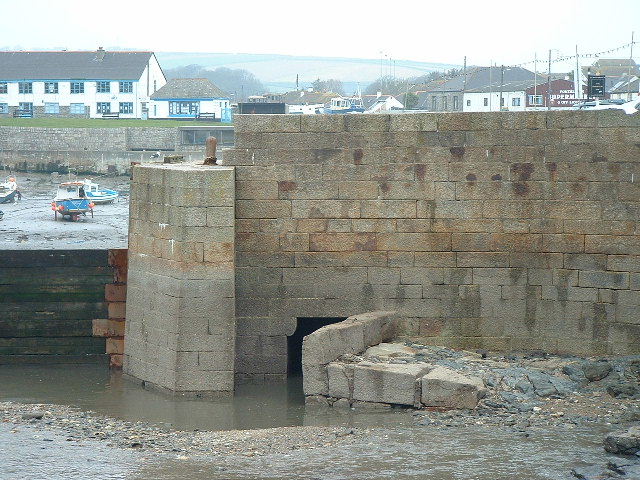
THIS WAS USED TO DIRECT THE WATER CAUGHT IN THE INNER HARBOUR ON AN EBBING TIDE TO SCOUR THE ENTRANCE CHANNEL.
The refuse water from the neighbouring mines was diverted by a culvert, and by preparing grooves, in which balks of timber were let down during stormy weather, the boats and shipping could remain secure during the severest gale. As a result of their exertions, the trade of the port and the prosperity of the fishermen greatly increased.
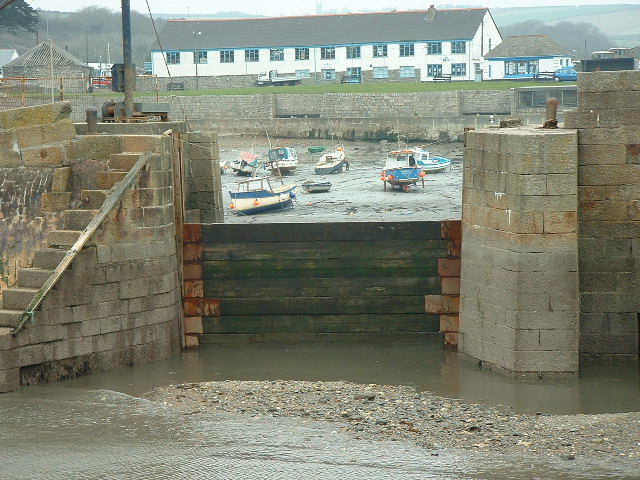
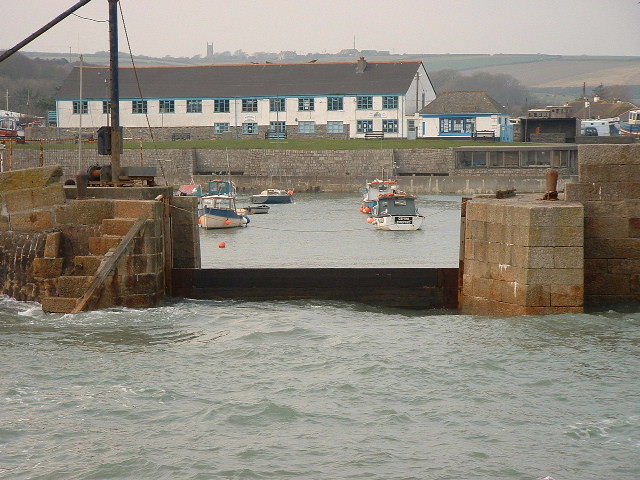
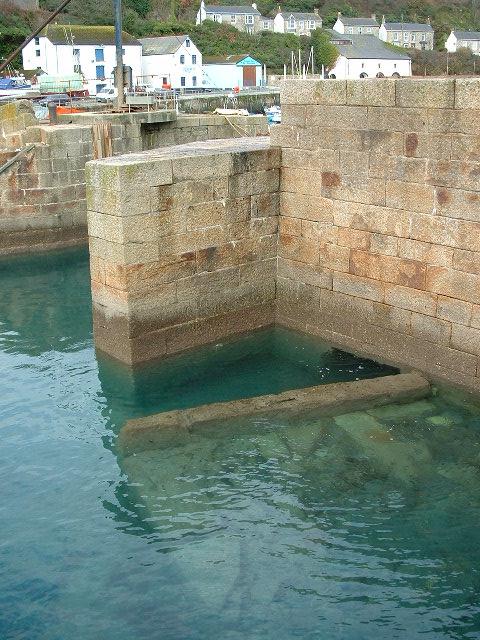
By the Act of Incorporation, the original promoters were empowered to levy certain rates and duties on articles imported and exported. From a perusal of the Schedules of the Act of 1869, we notice that the dues per ton of vessels frequenting the port, provide for ships of 120 tons and upwards. To import or export a hawk requires a levy of twopence, while for a bag of feathers the rate is ninepence. A side of bacon can be sent out for a due of sixpence, but a dining-table necessitates the payment of a fourpenny impost.
Apart from the steamer or sailing vessel, that may be frequently seen in the harbour, there is a more lively scene presented when the fleet of fishing-boats is preparing for sea, or leaving the basin. Their brown sails present a pleasing sight, and by contrast tend to increase the charm of the blue summer sea, while the presence of heaps of shining fish on the quays, bespeaks a welcome addition to the breakfast table.
About seventy years ago, the first attempt at fishing for mackerel was made, when the late Mr. Thomas Jacka had a boat built for that branch of the fishery. One Friday afternoon, about twelve years later, the little fleet of Porthleven boats, mostly of small size, proceeded to sea, with every promise of a fine night. The weather was mild, and the wind, if any, was “off the land.” They had not gone long before the sky became overcast, and the wind increased to a hurricane. What would become of the boats ? Not one came into harbour that night. They were scattered hither and thither. All night long there were weeping and loud cries heard in the village for absent fathers, sons, and husbands: Yet no life was lost. One boat reached Mullion, and the occupants were hauled by ropes up the cliff, but with faces so battered that their relatives failed to recognize them on their return. Most of the boats reached Porthleven in safety, though some of the men were so weak from exposure, that they had to be assisted to their homes. The Ark was unheard of for a fortnight, when news was received from the crew, who had been taken to Rotterdam, whence in due time they arrived at Porthleven. For many years an annual Thanksgiving Service was held in the old Porthleven Baptist Chapel (now a storehouse of the Harbour Company) to commemorate the preservation of the fishermen during the Great Storm.
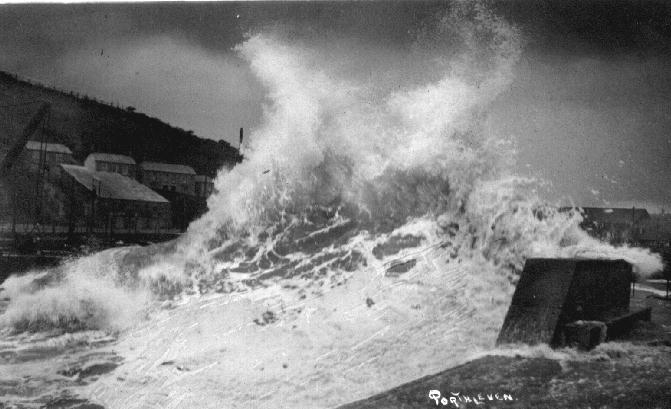
In 1848, sixty-three boats, of all sizes, belonged to the port. About twenty were engaged in the mackerel fishery. Perhaps it will not be uninteresting if we select a few names from the list of the old fishing-fleet, all gone at the present time with one or two exceptions.
Shall we attempt a classification-
BIRDS : Dove, Lark.
PLANTS AND TREES : Pink, Olive, Laurel, Vine.
VARIOUS: Ant, Drone, Pilchard, Beehive !
Besides the mackerel fishery, the boats are engaged in fishing for herrings, pilchards, and in the shell-fishery. Hook-and-line fishing is also vigorously prosecuted. The largest sized boats are among the finest modelled and best equipped in the kingdom. Most, if not all, have been built on the Bank, at the northern head of the inner basin at Porthleven.
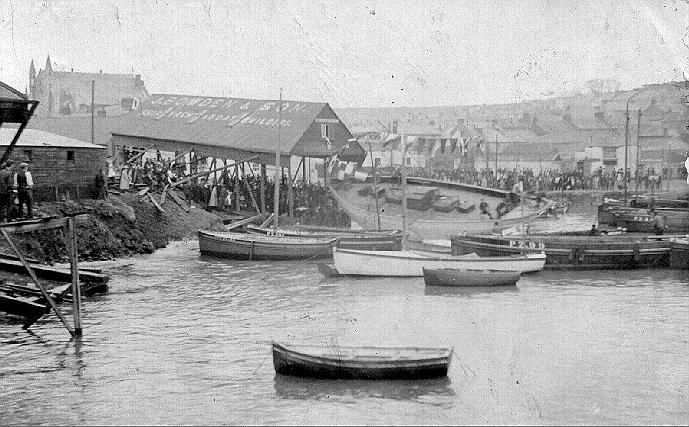
One local builder has just launched his fifteenth boat. When setting out for the Scotch herring-grounds, or for the Plymouth mackerel season, they are well manned and provisioned. They have excellent sailing qualities, and are capable of enduring great stress of weather. Being fitted with every convenience- e.g., sleeping-berths, cooking-stoves, and all necessary utensils, they are prepared for any emergency. We may remark, en passant, that the present year opened most propitiously for the fishermen.
Nearly 200,000 mackerel were secured atthe commencement of the Plymouth season.
The sale realized about £3000.
This result, in the time, is the most remarkable on record at Porthleven. The whole were secured in about a fortnight. The smaller class boats are employed in the pilchard drift fishery, as before intimated. These, with the ” hookers ” and ” crabbers,” may frequently be seen returning from the deep with a goodly burden of silvery fish, or with well-filled mawn of crabs, crayfish, or lobsters.
Connected with the pilchard fishery is the system of fish-curing. When the catches are large, and when the demand is consequently less, with a corresponding diminution in prices, the fish are not put into the market, but are taken into port and carried in baskets, etc., to the fish cellars. Here they are ” huddled ” in heaps, mixed with salt, and after three or four weeks transferred into the casks or hogsheads (loc. hosgeds). After a large percentage of their oil has been pressed out, the pilchards are ready for shipment to the Mediterranean markets. This fishcuring time is an occasion of activity amongst the whole household, and is a season for congratulation at the prospect of securing a few winter comforts. About a thousand hogsheads were thus prepared at Porthleven during the last season.
To prosecute his labours, the fisherman must be provided with his outfit: how is this secured?
To screen his body from piercing winds, loving fingers are busy knitting a strong, warm worsted frock or jersey, also long comfortable stockings. But worsted is a poor shelter from the drenching spray and driving rain, so there is a demand on the females for the supply of other garments. A “jumper” is made of “duck,” and over both is the “oiler,” a covering of ” unbleached ” made waterproof.For his head there is a “sou’-wester ” of oiled cloth, well padded inside with flannel; while strong ” sea-boots,” reaching to his thighs, complete his usual costume.
Besides the making and mending of the clothing, there are nets to be provided and repaired. Here, too, the women and elder girls render great assistance. Mesh after mesh is formed by practised hands, until the net is finished. Sometimes a huge rent, made by the vessel or torn by the ” dogs” (dog-fish), requires their patient attention, while father is busy “barking” his new mackerel net, tarring his boat, or oiling his boots, and while brother is making a crab-pot of wickerwork.
Besides the individual efforts of the family to provide the necessary nets, machine power has been utilised in this direction. At Mr. B. H. Eddy’s net-works ten machines are at work, employing sixteen men and boys. There are twenty-five other employes, and all are engaged as workmen, work girls, travellers, or clerks, in this important industry. A visit to the works reveals the nature and amount of the business transacted. The various processes can be traced whereby the American cotton becomes converted into the finished net, ready for immediate use. In addition to the ordinary sea-fishery nets, Mr. Eddy manufactures salmon, aviary, and horticultural netting and shading, as well as conservatory blinds and lawn-tennis nets. His travellers visit the most important ports and towns of England, while his business transactions extend over the United Kingdom.
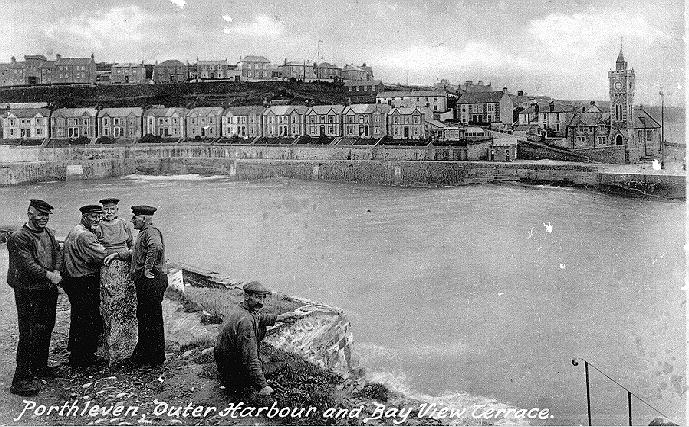
Before leaving the description of our fisherman and his occupation, we would add a word or two in regard to his general character. He is sturdily honest, and has won more than a local reputation for strict sobriety and orderly conduct. His encounters with the storm and the billows have given him that daring intrepidity which is the boast of our British seafaring population. Towards his family his tenderness is marked, while his love of home is proverbial. He is eminently loyal, – as was demonstrated by the reception given to H.R.H. the Duke of Edinburgh, while on a visit to the Coast Guard Station, May 31st, 1881, -invariably observant of the Sabbath, and strongly attached to the religious services of the sanctuary.
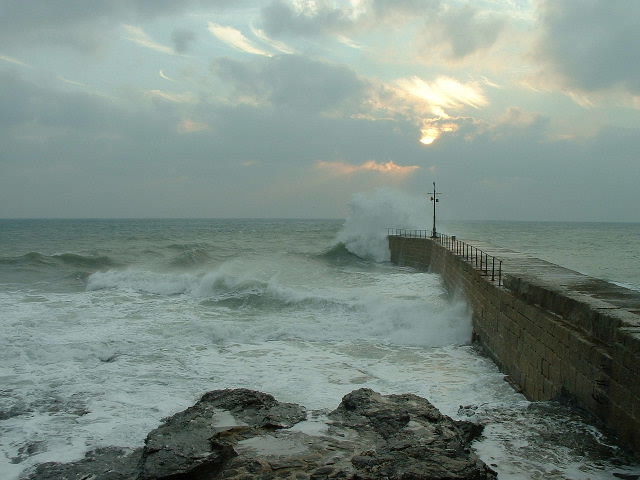
PORTHLEVEN HARBOUR CONSTRUCTION
RECEIPTS & EXPENDITURE 1811 – MAY 22nd 1814
Received from Proprietors under the Company`s Act:
£22,374. 19. 10
Received from Loan of Mr. Richard Davis:
£ 2,000
Received from Rents at the Harbour:
£45. 12. 6
TOTAL: £24,420. 12. 4
(Twenty Four Thousand Four Hundred and Twenty Pounds, twelve shillings and four pence).
Surveys, and soliciting Incorporation Act:
£2,547. 6. 3
Soliciting New Act:
£386. 17. 1
Earthwork, Masonry, Stone, Timber, Labour, Salaries, etc:
£11,159. 2. 4
Purchases of Estates within Harbour limits, Interest on Loan:
£6,574. 0. 0
Cash in hands of Director of works (A. Blair, Esq.) and Treasurer:
£3,753. 6. 8
TOTAL: £24,420.12.4
(Signed) T.G. VANDER GUCHT
Clerk to the Company
EXTRACTS FROM CAPTAIN BLAIR`S `REPORT OF PROGRESS OF THE WORK`, APRIL 20th, 1814.
PIER
Carried out with nearly 74,870 cubic feet firm masonry, consisting of moorstone and granite, connected by excellent mortar, composed of Aberthaw lime and ironstone sand, and tree-nailed where thought necessary.
Total expense £11,870.
To prevent return of sand and gravel 1,100tons more stone required.
Cost £2,310
During last winter in strong southerly gales a very small quantity of gravel appeared to have been washed over the lower part of it. One of the pier stones during S.W. gales was raised from its place by the force of the sea, and carried to a distance of 56 feet. It weighed 1ton 181 cwt.
GRAVEL REMOVED:
(a) From Channel.
Space 400feet by 300 feet and 7 feet deep, 40,000 tons. Cost £300.
(b) From interior channel
100feet long: 30 av. breadth 14feet deep. £200 cost.
WAREHOUSE NEARLY COMPLETED
56 feet long, 25 feet wide, three storeys high. This formed winter employment for the masons, and part of the labourers. Worth £800.
Excavated space near Warehouse. For Coal Yard.
Stone used for facing wharves.
WORK TO BE DONE TO SUIT 50 VESSELS 0F 200 TONS EACH
Ground Excavations:-
1,200 feet x 250 feet x 28 feet = 8,400,000 cubic feet, or 381,814 tons.
Cost £4,772
Posts, Rings, Chains, and Cranes to be fixed.
Cost, £500
Wharves to be Constructed.
Local stone – lime only upper part – to be faced with moorstone.
Basin. For future consideration.
A little Tin has been found in the excavations; more is expected.
Tin-streaming was tried here about twentyyears ago in two places; there were small returns.
Theprospect of a permanent Peace makes it bright for the future.
(Signed) A. BLAIR,
Director of the Works.
PORTHLEVEN, April 20th, 1814
THE PIER at SPRING LOW TIDE
